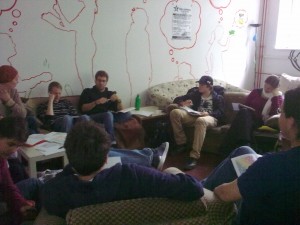Im Rahmen des bundesweiten Bildungsstreiks hat der postironische Kopfverband an der Universität Hamburg ein Seminar angeboten. Natürlich ging es dabei um Postironisches. Wir haben mit einer Gruppe von 16 Menschen das postironische Manifest gelesen und diskutiert.
Wir stellten fest, daß ein Manifest selbstbezüglich ist und einen Standort bestimmen möchte. In unserem Fall heißt das, dass das Manifest selbst zum Zweifeln anregen muss. Alle waren sich einig, dass es dies bewirkt, denn es ist soweit Sinn entleert, dass man sich Gedanken machen muss, wo Sinn entstehen kann.
Desweiteren stellten wir fest, dass das postironische Manifest nichts feststellt, also nichts starr festmacht, sondern der Vielfalt und den Möglichkeiten Raum gibt. Dabei passiert es, dass feste Kategorien angelöst werden, aufgelöst werden und Grenzen verschwimmen.
In dieser Bewegung kann Raum entstehen. Raum für: Schönheit, Wahrheit, Liebe. Das zeugen von Schönheit würde dann immer mehr Schönheit zeugen.

